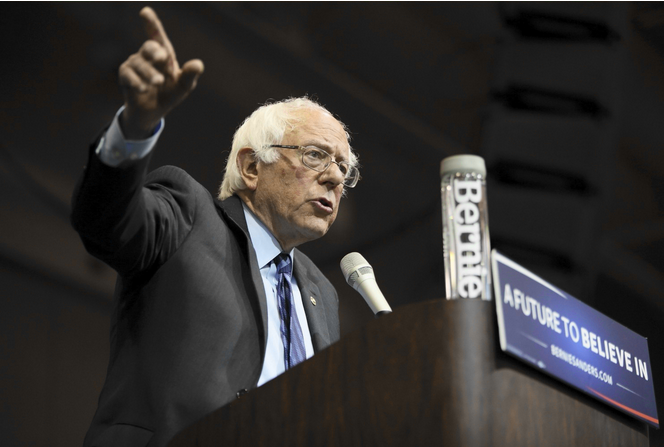
Let’s examine what Bernie Sanders supporters did in his name over the weekend.
As the Nevada Democratic convention voted to award a majority of delegates to Hillary Clinton — an accurate reflection of her victory in the state’s February caucuses — Sanders backers charged the stage, threw chairs and shouted vulgar epithets at speakers. Security agents had to protect the dais and ultimately clear the room.
Sanders supporters publicized the cellphone number of the party chairwoman, Roberta Lange, resulting in thousands of abusive text messages and threats:
“Praying to God someone shoots you in the FACE and blows your democracy-stealing head off!”
“Hey bitch. . . We know where you live. Where you work. Where you eat. Where your kids go to school/grandkids. . . Prepare for hell.”
Veteran Nevada reporter Jon Ralston transcribed some of the choice voicemail messages for the chairwoman, some with vulgar labels for women and their anatomy:
“I think people like you should be hung in a public execution. . . . You are a sick, twisted piece of s--- and I hope you burn for this!”
“You f---ing stupid bitch! What the hell are you doing? You’re a f---ing corrupt bitch!”
The day after the convention, Sanders supporters vandalized party headquarters with messages saying, among other things, “you are scum.”
And the candidate’s response to the violent and misogynistic behavior of his backers? Mostly defiance. Asked by reporters Tuesday about the convention chaos — in which operatives from his national campaign participated — Sanders walked away in the middle of the question.
Finally, mid-afternoon Tuesday, Sanders released a statement saying, “I condemn any and all forms of violence, including the personal harassment of individuals.” But he blamed the Nevada party for preventing a “fair and transparent process,” and he threatened Democrats: “If the Democratic Party is to be successful in November, it is imperative that all state parties treat our campaign supporters with fairness and the respect that they have earned.”
It is no longer accurate to say Sanders is campaigning against Clinton, who has essentially locked up the nomination. The Vermont socialist is now running against the Democratic Party. And that’s excellent news for one Donald J. Trump.
“The Sanders Campaign spent its time either ignoring or profiting from the chaos it did much to create,” the Nevada Democratic Party wrote in a formal complaint to the Democratic National Committee. The state party wrote, “Part of the approach by the Sanders campaign was to employ these easily-incensed delegates as shock troops.” The Sanders representatives “at the times of most intense crisis offered little more than shrugs and smirks.”
The Nevada Democrats, warning of similar disruptions at the national convention in July,accused the Sanders campaign of “inciting disruption — and, yes, violence,” and said, “the goal of many of these individuals, sanctioned or encouraged by the Sanders campaign, is not party-building but something more sinister.”
A few weeks ago, I wrote that I wasn’t concerned about Sanders remaining in the race until the very end, because he doesn’t wish to see a President Trump and will ultimately throw his full support to Clinton. Sanders has, indeed, lightened up on Clinton and is instead trying to shape the Democrats’ platform and direction. But his attacks on the party have released something just as damaging to the causes he professes to represent. Coupled with his refusal to raise money for the party, his increasingly harsh rhetoric could hurt Democrats up and down the ballot in November and beyond.
“We are taking on virtually the entire Democratic establishment,” Sanders proclaims.
“The Democratic Party has to reach a fundamental conclusion: Are we on the side of working people or big-money interests?” he asks.
“The Democratic Party up to now has not been clear about which side they are on on the major issues facing this country,” he announces.
This was Ralph Nader’s argument in 2000: There isn’t much difference between the two parties. It produced President George W. Bush. Sanders said at the start of his campaign that he wouldn’t do what Nader did, because there is a difference between the parties.
Yet now his supporters, the Nevada Democratic Party says, are behind “physical threats and intimidation,” “scuffles, screams from bullhorns, and profane insults” and “numerous medical emergencies among delegates pressed up against the dais.”
This, even though they were wrong on the merits. Ralston writes that “the Sanders folks disregarded rules, then when shown the truth, attacked organizers and party officials as tools of a conspiracy to defraud the senator of what was never rightfully his in the first place.”
And this, despite only two additional delegates being at stake, as The Post’s Philip Bump points out — not enough to make a difference in the race.
More to the point, no grievance justifies what happened in Nevada. Yet Sanders, recklessly, is fueling the fire.d
- Publish my comments...
- 0 Comments
